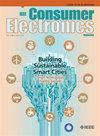Efficient Hybrid Multi-Population Genetic Algorithm for Multi-UAV Task Assignment in Consumer Electronics Applications
IF 10.9
2区 计算机科学
Q1 ENGINEERING, ELECTRICAL & ELECTRONIC
引用次数: 0
Abstract
In recent years, as people’s living standards have improved and consumption concepts have been transformed, the demand for purchasing consumer electronics online has continued to grow, further stimulating the development of the logistics industry. Consequently, how to deliver consumer electronics to households at minimal cost has become a crucial factor that limits the development of the consumer technology industry. To tackle this problem, this paper studies the task assignment problem for multiple initially dispersed UAVs to deliver products to target locations while minimizing their total operation time. Each UAV can continuously provide delivery services to multiple target locations within its limited loading capacity and operation time. To solve this problem, we propose several hybrid multi-population genetic algorithms. First, a novel crossover operator for the genetic algorithms is designed, through which a single parent chromosome can generate offspring individually. Second, two mutation mechanisms are performed to increase gene diversity. Third, multiple local search strategies are employed to enhance the populations’ fitness during each iteration of evolution. An improved 2-opt local search strategy is applied to optimize individual chromosomes when their similarity with the current best chromosome falls below a prescribed threshold. Alternatively, local search strategies are utilized for 1-opt, 2h-opt, and interchange processes. Combining local search strategies, genetic operators, and the multi-population mechanism leads to several hybrid multi-population genetic algorithms. Numerical simulations and experimental tests demonstrate that the hybrid multi-population genetic algorithm, integrated with the improved 2-opt and 1-opt local search strategies, exhibits superior performance among the designed hybrid genetic algorithms, the minimum marginal cost algorithm (MMA), and the existing popular Co-evolutionary Multi-population Genetic Algorithm (CMGA). In experimental scenarios, the hybrid multi-population genetic algorithm significantly improves CMGA and MMA, reducing UAVs’ total operation time by 4.8% and 13.8%, respectively. This demonstrates its efficiency in meeting the growing demand for low-cost delivery of consumer electronics. This method ensures that logistics operations remain agile and approachable to growing market needs, reinforcing the consumer technology industry’s capability to meet customer expectations in a viable landscape.消费类电子应用中多无人机任务分配的高效混合多种群遗传算法
近年来,随着人们生活水平的提高和消费观念的转变,网上购买消费电子产品的需求持续增长,进一步刺激了物流业的发展。因此,如何以最低的成本将消费电子产品交付给家庭已成为限制消费技术行业发展的关键因素。为了解决这一问题,本文研究了初始分散的多架无人机的任务分配问题,以最小化其总运行时间。每架无人机可以在有限的装载能力和操作时间内连续向多个目标地点提供交付服务。为了解决这一问题,我们提出了几种混合多种群遗传算法。首先,设计了一种新的遗传算法交叉算子,使单亲本染色体能够单独产生后代;其次,通过两种突变机制来增加基因多样性。第三,在每次迭代进化过程中,采用多种局部搜索策略来增强种群的适应度。当单个染色体与当前最佳染色体的相似度低于规定阈值时,采用改进的2-opt局部搜索策略对单个染色体进行优化。另外,本地搜索策略可用于1-opt、2h-opt和交换过程。结合局部搜索策略、遗传算子和多种群机制,产生了几种混合多种群遗传算法。数值仿真和实验验证表明,结合改进的2-opt和1-opt局部搜索策略的混合多种群遗传算法,比所设计的混合遗传算法、最小边际成本算法(MMA)和现有流行的协同进化多种群遗传算法(CMGA)具有更好的性能。实验场景下,混合多种群遗传算法显著改进了CMGA和MMA算法,使无人机的总运行时间分别缩短4.8%和13.8%。这证明了它在满足消费者对低成本电子产品日益增长的需求方面的效率。这种方法确保了物流操作保持敏捷性和可接近不断增长的市场需求,加强了消费技术行业在可行的情况下满足客户期望的能力。
本文章由计算机程序翻译,如有差异,请以英文原文为准。
求助全文
约1分钟内获得全文
求助全文
来源期刊
CiteScore
7.70
自引率
9.30%
发文量
59
审稿时长
3.3 months
期刊介绍:
The main focus for the IEEE Transactions on Consumer Electronics is the engineering and research aspects of the theory, design, construction, manufacture or end use of mass market electronics, systems, software and services for consumers.

 求助内容:
求助内容: 应助结果提醒方式:
应助结果提醒方式:


